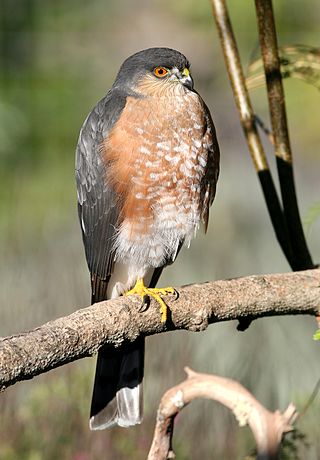
The sharp-shinned hawk, commonly known as a sharpie, is a small hawk, with males being the smallest hawks in the United States and Canada, but with the species averaging larger than some Neotropical species, such as the tiny hawk. The taxonomy is far from resolved, with some authorities considering the southern taxa to represent three separate species: white-breasted hawk, plain-breasted hawk, and rufous-thighed hawk. The American Ornithological Society keeps all four variations conspecific.

The barramundi or Asian sea bass, is a species of catadromous fish in the family Latidae of the order Perciformes. The species is widely distributed in the Indo-West Pacific, spanning the waters of the Middle East, South Asia, Southeast Asia, East Asia, and Oceania.
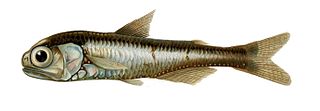
Lanternfish are small mesopelagic fish of the large family Myctophidae. One of two families in the order Myctophiformes, the Myctophidae are represented by 246 species in 33 genera, and are found in oceans worldwide. Lanternfishes are aptly named after their conspicuous use of bioluminescence. Their sister family, the Neoscopelidae, are much fewer in number but superficially very similar; at least one neoscopelid shares the common name "lanternfish": the large-scaled lantern fish, Neoscopelus macrolepidotus.

Ridgeheads, also known as bigscales, are a family of small, deep-sea stephanoberyciform fish. The family contains approximately 37 species in five genera; their distribution is worldwide, but ridgeheads are absent from the Arctic Ocean and Mediterranean Sea. Although the family is one of the most widespread and plentiful of deep-sea families, none of its members are of interest to commercial fishery.

Warming's lantern fish, Ceratoscopelus warmingii, is a lanternfish of the family Myctophidae, found circumglobally in both hemispheres, at depths of between 700 and 1,500 m during the day and between 20 and 200 m at night. Its length is about 8 cm (3.15 in).

The blackmouth lanternshark is a species of dogfish shark within the family Etmopteridae. This species is part of a subgroup that includes one other species from within the family. It is known to inhabit the benthic zones of the Eastern Indian Ocean and the Arafura Sea. These sharks were first described in a 2002 issue of Cybium: International Journal of Ichthyology, and there is still much unknown about the species.
Metelectrona is a genus of lanternfishes.
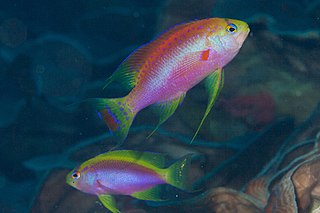
Pseudanthias ventralis, the longfin anthias or longfin basslet', is a species of marine ray-finned fish, an Pseudanthias from the subfamily Anthiinae part of the family Serranidae, the groupers and sea basses. It is found in the Western Pacific Ocean.

Notoscopelus elongatus is a species of lanternfish in the family Myctophidae. It is endemic to the Mediterranean Sea where it is found in deep water habitats, rising to near the surface to feed at night and descending to great depths by day. It is a common species with no particular threats, and the International Union for Conservation of Nature has listed its conservation status as being of least concern.
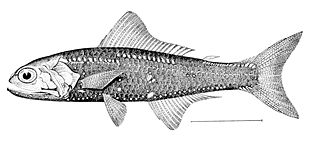
Notoscopelus resplendens, commonly known as the patchwork lampfish or patchwork lanternfish, is a species of lanternfish in the family Myctophidae. It is found in the eastern and western Atlantic Ocean, the Indian Ocean and parts of the Pacific Ocean. It spends the daylight hours in deep water, rising at night to near the surface. This fish was first described by the Scottish naturalist and arctic explorer John Richardson in 1845.
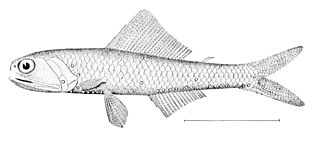
Notoscopelus caudispinosus is a species of lanternfish in the family Myctophidae. It is found in the eastern and western Atlantic Ocean, the Indian Ocean and parts of the Pacific Ocean. It spends the day below 1,000 m (3,300 ft), rising towards the surface to feed at night.
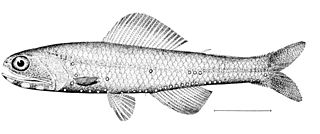
Notoscopelus kroyeri, commonly known as the lancet fish, is a species of lanternfish in the family Myctophidae. It is endemic to the North Atlantic Ocean where it is found in deep water habitats, spending its day at great depths and its night near the surface. It was previously regarded by some authorities as being a subspecies of Notoscopelus elongatus; one of the differences between the two being that N. elongatus has 25 or fewer gill rakers while N. kroyeri has 26 or more.

Gonichthys cocco, often called the Cocco's lanternfish, is a species of oceanodromous lanternfish.
The longfin lanternfish is a species of oceanodromous lanternfish that is oviparous, and a host of Sarcotretes scopeli.

Cephalopholis igarashiensis, known as the garish hind, Neptune grouper, goldbar grouper, or Japanese cod, is a deepwater species of marine ray-finned fish, a grouper from the subfamily Epinephelinae which is in the family Serranidae which also includes the anthias and sea basses. It is found on coral reefs at depths of 80 to 250 m in the Indo-Pacific.

The headlight fish is a species of lanternfish in the family Myctophidae. It is also sometimes referred to as the headlight lanternfish, or even the lanternfish, though it is not the only species to be called this.

Cocco's lantern fish, also called Gemellar's lanternfish, is a species of lanternfish.
Leptostomias gladiator is a species of fish in the family Stomiidae. It is sometimes called the scaleless dragonfish, but that name is shared with many other species.
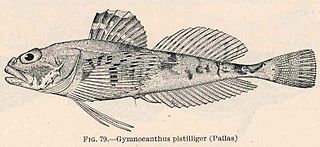
Gymnocanthus pistilliger, the threaded sculpin, is a species of marine ray-finned fish belonging to the family Cottidae, the typical sculpins. This species occurs in the northern Pacific Ocean.















